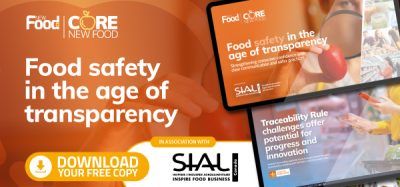Transparency and data quality: new cross-cutting EFSA guidance in a nutshell
- Like
- Digg
- Del
- Tumblr
- VKontakte
- Buffer
- Love This
- Odnoklassniki
- Meneame
- Blogger
- Amazon
- Yahoo Mail
- Gmail
- AOL
- Newsvine
- HackerNews
- Evernote
- MySpace
- Mail.ru
- Viadeo
- Line
- Comments
- Yummly
- SMS
- Viber
- Telegram
- Subscribe
- Skype
- Facebook Messenger
- Kakao
- LiveJournal
- Yammer
- Edgar
- Fintel
- Mix
- Instapaper
- Copy Link
Posted: 3 August 2017 | EFSA, New Food | No comments yet
Two new guidance documents – on the weight-of-evidence approach and biological relevance assessment – will help to further harmonise methodologies across the areas in which EFSA works.


Scientific methods are the recipes of scientific assessments. A cookery recipe indicates the scope (e.g. so many servings), a list of ingredients and instructions for preparation. Assessment methodologies are just as important in food safety.
Prof Tony Hardy, Chair of EFSA’s Scientific Committee, said: “Our scientific ‘recipes’ state the questions we’ve been asked, our evidence needs and assumptions – including how we use expert judgement – and a plan of execution.
“These new guidance documents will help in transparently and consistently reporting all of this information, which is essential in ensuring that the assessment process and its conclusions are understandable.
“To complete the analogy, they have to be fit for consumption so our advice is trusted.”
Harmonising approaches across EFSA’s scientific panels
EFSA’s Scientific Committee has developed three key methodological frameworks to improve the robustness, quality and transparency of the scientific assessments done by EFSA’s 10 sectoral scientific panels:
- Weight of evidence – a practical three-step approach for assembling, weighing and integrating evidence on the basis of its reliability, relevance and consistency; it considers qualitative and quantitative approaches and provides simplified reporting tools.
- Biological relevance – a flexible framework that clarifies definitions and concepts and sets criteria for determining the nature/magnitude of an observed effect and for deciding if the effect seen is adverse, beneficial or neither (i.e. relevant for an assessment).
- Uncertainty – how to assess and combine the limitations in our knowledge at the time of the assessment and identify the data gaps that need filling (to reduce uncertainty).
The first two pillars of this harmonised approach are published today. Guidance on uncertainty has been trialled internally at EFSA over the past year. Based on the experience, it will be fine-tuned and finalised in late 2017/early 2018 to complete the series.
Prof Hardy added: “These three documents are interlinked building blocks that will make our assessments more robust and transparent, founded on the best quality data available, and better able to help decision-makers ensure European food safety.”









